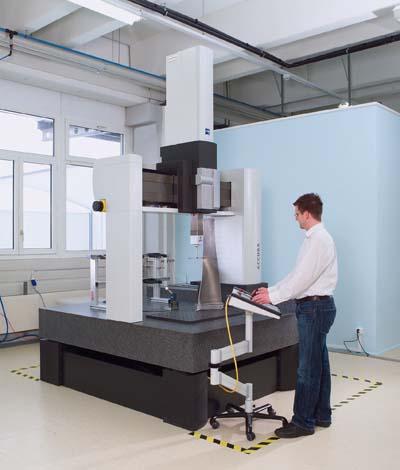
May 5, 2009 — Systematically implementing customer requests was the main challenge in the development of the new ACCURA coordinate measuring machine from Carl Zeiss IMT Corp. The result is a multisensor-capable measuring system that permits fast, economical, precise and flexible measurements, primarily due to the use of the latest technologies such as foam insulating technology. As with a versatile modular system, customers can configure the ACCURA to fit their requirements. Based on their current tasks, they select the ideal configuration, i.e. sensors. Special software, such as GEAR PRO for gears and HOLOS NT for free-form surface measurements, is integrated along with CALYPSO, the standard CAD-based measuring software from Carl Zeiss. Subsequent modifications can be made very easily. The ACCURA is available at a very economical price for this performance class. If requirements change, different sensors and software can be easily added. Whether cut, shaped or molded parts, plastic or steel, all options of coordinate measuring technology are available. The ACCURA also permits the integration of MASS technology from Carl Zeiss. Combined with an RDS articulating probe holder, MASS permits the fast, measuring program-guided change between contact sensors and the ViScan and LineScan optical sensors during a CNC run. The contact measuring sensors of the VAST family and the DT single-point sensor can also be used in various configurations. The ACCURA bridge features a new, high-performance insulation foam insulating technology. At minimal thickness, the housing covers ensure temperature resistance. This guarantees the required precision even on the shopfloor. Measuring machines must be operated at constant temperatures to avoid temperature-dependent deformations. A fixed measuring lab temperature of 20 degrees C is standard. The new ACCURA can be operated with the same precision at other temperatures between 20 and 26 degrees C. The measuring lab temperature can thus be selected freely and you save air conditioning costs. Thanks to the steel and aluminum components, the measuring machine bridge is extremely rigid and slim. The CARAT coating (Coated Ageing Resistant Aluminum Technology) on the aluminum parts ensures long-term stability of guideway behavior. The low weight of the moving parts improves the dynamics. This allows the ACCURA to achieve a maximum vectorial travel speed of 800 millimeters per second, 50 percent faster than its predecessor in the Performance Package configuration. This speed demands increased protection measures. Therefore, the Performance Package contains a special safety system: laser scanners monitor the protection zone around the measuring machine during the high-speed mode. If the safety system registers movement within this zone, the machine speed is automatically lowered within one second. Once the disruption passes, ACCURA reaccelerates to the original measuring speed. The enhanced air bearings also play a key role in the dynamic behavior of the bridge. Thanks to the thinner air gap, they are more rigid and require less compressed air than previous air bearings. The new ACCURA is currently available in four sizes, each of which offers a large measuring range even with an integrated stylus changer. For example, the smallest model has a measuring range (X x Y x Z) of 900 x 1400 x 800 millimeters, thus around a 40 percent larger measuring range. Nonetheless, the high measuring accuracy was maintained. The linear measuring tolerance is 1.6µm + L/333. A larger measuring range of 1200 x 2400 x 1000 millimeters is also available. If required, the new ACCURA is also available with a lower base.
Contact Details
Related Glossary Terms
- computer numerical control ( CNC)
computer numerical control ( CNC)
Microprocessor-based controller dedicated to a machine tool that permits the creation or modification of parts. Programmed numerical control activates the machine’s servos and spindle drives and controls the various machining operations. See DNC, direct numerical control; NC, numerical control.
- tolerance
tolerance
Minimum and maximum amount a workpiece dimension is allowed to vary from a set standard and still be acceptable.

